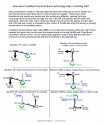Pulling from the past BROL conversation where this exact conversation got diverted.... I want to add some of my muscle engagement observations.
In my personal experience The upper body stuff comes into play when I want it to; I can bridge on my Silvio and Vendetta just like I could on my Trike and any other stick bikes I've tried. But if I grab those handle bars, pull hard and sit up just a bit; I can accelerate very very fast on a MBB. If I then pump and rock the nose rhythmically with my pedaling ala a DF I go even faster (up hill or on the flat). Last night I did just that goofing around a local 1 mile Strava sprint segment; I finish with the KOM by 20 seconds beating out some guys from a pace line; watching the KOM comparative replay I beat them on the final climb where I was full body attacking. I also did it at 11pm in the dark; add some light and I would have gonna a lot harder in on the down hill part. Winning via the uphill demonstrates something is up.
When doing that rhythmic pumping, it's not the same as a DF, I know what wheel bending,deflecting power and scub feels like on my old carbon wonderbike I did that for years; it's not that; there is no scrub on the Vendetta So what is it?
BTW, I think I am going to start callnig the Vendetta my Aluminum wonderbike; it's only fair after-all.

I think there is a component here that is analogous to "Free weights" in the gym that applies. Body builders lift free weights because all of the stabilizing muscle come into play; more stuff working and stress means better muscle development throughout the limb being used. You just can't get that on a ridge, fixed position, weight machine. MBB feels like that.
So my current Postulate is that most bents and trikes are very static machines; that force you into very fixed position and encourage the human to produce a machine like consistent power stroke that uses a fix and finite set of muscles. That consistence is not what the human body really excels at and fatigue is quick to prove it to the doubters (yes you can train to be really good at that; but that's the 1% elites that do). This static application of power is why on a tradition bent (is there such a thing?) bridging works, heart rates stay down, why fatigue seems to limit the high end exertion, and lastly why it can really stress the knees (just like pedals without float).
Meanwhile on the MBB the front is moving and as a result there is no true fixed leg motion; it's not locked it a single plane; it moves around; and you have to bring an the extra micro muscles into play to stabilize everything; and those non perfectly aligned muscles can contribute to the effort and allow for a more distributed load, yield more power for longer.
I don't really think my arm pulling back on the handbar is putting power to the pedal but it's allowing me to use additional leg muscle to contribute to the push; and giving me a slight bonus of the "leveler" that is the boom changing the angle through the power stroke.
The challenge I present people who don't believe the MBB potential is this:
Go ride 6 pieces of machinery:
1) Stationary Upright Computer Cycle (heath club life cycle)
2) Stationary Recumbent Computer Cycle
3) a Recumbent Trike
4) a Recumbent Stick bike
5) any MBB bike
6) any DF Race Bike
1-4 ride very much the same and the exertions feel the same. They all have very very stable, solid and predictable riding positions and it's hard NOT to ride them locked in smooth and even.
5-6 can be ridden on demand in a very destabilized manner with lateral body motions; and they ride very much the same in that they feel looser, lighter, faster; and undeniably they accelerate at rates unmatched by 1-4. The exception to that would be to go out on a Fast light RWD Bent like a CA2 and Bridge and really lay into it; by adding a bunch of unnecessary left and right hip wiggle. I bet you find you can go just a bit faster. Actually I know you will because I do. Or perhaps you already done that and you know it works.
 There has been MUCH written about the physics behind climbing on a Cruzbike vs. a fixed-boom recumbent vs. a standard DF bike. However, much of it is buried deep in long threads scattered over the blogiverse. Here is an accessible place where you can view a force vector diagram, or watch a video, which explains what may be one reason our bikes climb so well.
There has been MUCH written about the physics behind climbing on a Cruzbike vs. a fixed-boom recumbent vs. a standard DF bike. However, much of it is buried deep in long threads scattered over the blogiverse. Here is an accessible place where you can view a force vector diagram, or watch a video, which explains what may be one reason our bikes climb so well.








